Human Resource Management Report: TESCO Workforce Planning
VerifiedAdded on 2020/11/23
|16
|4338
|30
Report
AI Summary
This report provides a comprehensive analysis of Human Resource Management (HRM) practices, focusing on the case of TESCO. It begins by outlining the purpose and functions of HRM relevant to workforce planning and resourcing, including recruitment, learning, training and development, job analysis, performance management, and compensation. The report then delves into the strengths and weaknesses of different recruitment and selection approaches, differentiating between internal and external recruitment methods, and various selection techniques. Furthermore, it examines the benefits of HRM practices within an organization, such as providing job security, training and development, and performance-based compensation. The report also discusses the effectiveness of HRM practices in increasing organizational productivity, including performance appraisal systems. Finally, it explores the importance of employee relations and key elements of employment legislation and their impact on HRM decision-making, offering a holistic view of HRM's role in organizational success.

Human Resources
Management
Management
Paraphrase This Document
Need a fresh take? Get an instant paraphrase of this document with our AI Paraphraser

Table of Contents
INTRODUCTION...........................................................................................................................3
LO 1.................................................................................................................................................3
P1 The purpose and functions of HRM that applicable to workforce planning and resourcing
an organization. ..........................................................................................................................3
P2 The strengths and weakness of different approaches to recruitment and selection...............5
LO 2.................................................................................................................................................6
P3 Benefits of HRM practices within an organisation ...............................................................6
P4 Effectiveness of different HRM practices in increasing the organisational productivity......8
LO 3.................................................................................................................................................9
P5 Importance of the employee relation in influencing HRM decision making.........................9
P6 Key elements in employment legislation and its impact on the HRM decision making.....10
LO 4...............................................................................................................................................11
P7 HRM practices ....................................................................................................................11
CONCLUSION..............................................................................................................................13
REFERENCES..............................................................................................................................14
INTRODUCTION...........................................................................................................................3
LO 1.................................................................................................................................................3
P1 The purpose and functions of HRM that applicable to workforce planning and resourcing
an organization. ..........................................................................................................................3
P2 The strengths and weakness of different approaches to recruitment and selection...............5
LO 2.................................................................................................................................................6
P3 Benefits of HRM practices within an organisation ...............................................................6
P4 Effectiveness of different HRM practices in increasing the organisational productivity......8
LO 3.................................................................................................................................................9
P5 Importance of the employee relation in influencing HRM decision making.........................9
P6 Key elements in employment legislation and its impact on the HRM decision making.....10
LO 4...............................................................................................................................................11
P7 HRM practices ....................................................................................................................11
CONCLUSION..............................................................................................................................13
REFERENCES..............................................................................................................................14
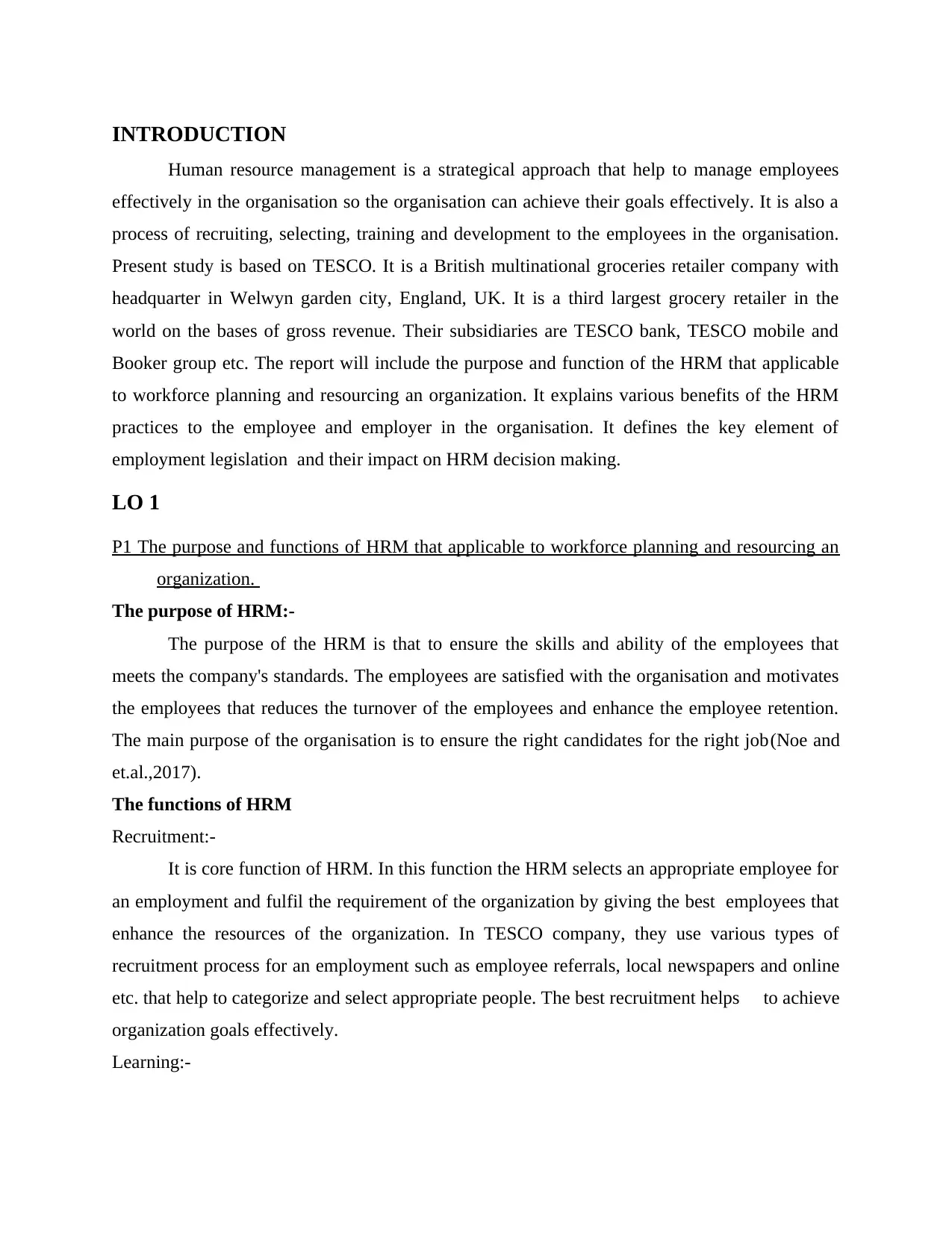
INTRODUCTION
Human resource management is a strategical approach that help to manage employees
effectively in the organisation so the organisation can achieve their goals effectively. It is also a
process of recruiting, selecting, training and development to the employees in the organisation.
Present study is based on TESCO. It is a British multinational groceries retailer company with
headquarter in Welwyn garden city, England, UK. It is a third largest grocery retailer in the
world on the bases of gross revenue. Their subsidiaries are TESCO bank, TESCO mobile and
Booker group etc. The report will include the purpose and function of the HRM that applicable
to workforce planning and resourcing an organization. It explains various benefits of the HRM
practices to the employee and employer in the organisation. It defines the key element of
employment legislation and their impact on HRM decision making.
LO 1
P1 The purpose and functions of HRM that applicable to workforce planning and resourcing an
organization.
The purpose of HRM:-
The purpose of the HRM is that to ensure the skills and ability of the employees that
meets the company's standards. The employees are satisfied with the organisation and motivates
the employees that reduces the turnover of the employees and enhance the employee retention.
The main purpose of the organisation is to ensure the right candidates for the right job(Noe and
et.al.,2017).
The functions of HRM
Recruitment:-
It is core function of HRM. In this function the HRM selects an appropriate employee for
an employment and fulfil the requirement of the organization by giving the best employees that
enhance the resources of the organization. In TESCO company, they use various types of
recruitment process for an employment such as employee referrals, local newspapers and online
etc. that help to categorize and select appropriate people. The best recruitment helps to achieve
organization goals effectively.
Learning:-
Human resource management is a strategical approach that help to manage employees
effectively in the organisation so the organisation can achieve their goals effectively. It is also a
process of recruiting, selecting, training and development to the employees in the organisation.
Present study is based on TESCO. It is a British multinational groceries retailer company with
headquarter in Welwyn garden city, England, UK. It is a third largest grocery retailer in the
world on the bases of gross revenue. Their subsidiaries are TESCO bank, TESCO mobile and
Booker group etc. The report will include the purpose and function of the HRM that applicable
to workforce planning and resourcing an organization. It explains various benefits of the HRM
practices to the employee and employer in the organisation. It defines the key element of
employment legislation and their impact on HRM decision making.
LO 1
P1 The purpose and functions of HRM that applicable to workforce planning and resourcing an
organization.
The purpose of HRM:-
The purpose of the HRM is that to ensure the skills and ability of the employees that
meets the company's standards. The employees are satisfied with the organisation and motivates
the employees that reduces the turnover of the employees and enhance the employee retention.
The main purpose of the organisation is to ensure the right candidates for the right job(Noe and
et.al.,2017).
The functions of HRM
Recruitment:-
It is core function of HRM. In this function the HRM selects an appropriate employee for
an employment and fulfil the requirement of the organization by giving the best employees that
enhance the resources of the organization. In TESCO company, they use various types of
recruitment process for an employment such as employee referrals, local newspapers and online
etc. that help to categorize and select appropriate people. The best recruitment helps to achieve
organization goals effectively.
Learning:-
⊘ This is a preview!⊘
Do you want full access?
Subscribe today to unlock all pages.

Trusted by 1+ million students worldwide

It is a main function and purpose of the HRM. In learning the HRM assist employee's
learning(Chang and Chin,2018). Organization who gives continues learning to the employees
that helps to generate huge revenue and achieve success to the organization. In TESCO, the
HRM significantly organized training and development programmes for enhance the knowledge
of the employees that helps to provide a strong workforce to the company and enhance the
resources of the organization.
Training and Development:-
It is provides by the employers to the new joining as well as existing employees. Training
helps to new employees to understand the cultural and structure of the organization. The HRM
also offer the professional development and leadership training to the employees that helps to
motivate them and create strong workforce in the organization. In TESCO company, the HRM
organized training and development programmes in every two months that enhance the
knowledge and learning experience to the employees that helps to achieve organizations goal in
effective manner.
Job analysis:-
It is a major function of the human resource management. It helps to analysis employee's
functions in the organization. It defines two documents: job description and job specification.
Organizations climate is changed due to globalization and it affects the work of the employees.
The data of job description and job specification helps to create job qualification and job
explanation of particular jobs in the organization(Banks and et.al.,2019). In TESCO, the HRM
defines various job description and job specification for each level of job that helps to understand
employees skills and abilities. This provides qualified workforce to the organization that helps to
achieve organizations goals.
Performance management:-
It is an effective procedure that HRM is used for measuring the job performance, identify
workforce meeting the standards and helps to maintain productive work groups in an
organization. In TESCO, the HRM measures employees performance on regular bases by
establishing objectives, providing ongoing coaching and appraising progress and feedback that
all help to know the employees effort towards the objectives that enhance the ability of the
workforce and achieve organizations goals.
Compensation and benefit:-
learning(Chang and Chin,2018). Organization who gives continues learning to the employees
that helps to generate huge revenue and achieve success to the organization. In TESCO, the
HRM significantly organized training and development programmes for enhance the knowledge
of the employees that helps to provide a strong workforce to the company and enhance the
resources of the organization.
Training and Development:-
It is provides by the employers to the new joining as well as existing employees. Training
helps to new employees to understand the cultural and structure of the organization. The HRM
also offer the professional development and leadership training to the employees that helps to
motivate them and create strong workforce in the organization. In TESCO company, the HRM
organized training and development programmes in every two months that enhance the
knowledge and learning experience to the employees that helps to achieve organizations goal in
effective manner.
Job analysis:-
It is a major function of the human resource management. It helps to analysis employee's
functions in the organization. It defines two documents: job description and job specification.
Organizations climate is changed due to globalization and it affects the work of the employees.
The data of job description and job specification helps to create job qualification and job
explanation of particular jobs in the organization(Banks and et.al.,2019). In TESCO, the HRM
defines various job description and job specification for each level of job that helps to understand
employees skills and abilities. This provides qualified workforce to the organization that helps to
achieve organizations goals.
Performance management:-
It is an effective procedure that HRM is used for measuring the job performance, identify
workforce meeting the standards and helps to maintain productive work groups in an
organization. In TESCO, the HRM measures employees performance on regular bases by
establishing objectives, providing ongoing coaching and appraising progress and feedback that
all help to know the employees effort towards the objectives that enhance the ability of the
workforce and achieve organizations goals.
Compensation and benefit:-
Paraphrase This Document
Need a fresh take? Get an instant paraphrase of this document with our AI Paraphraser
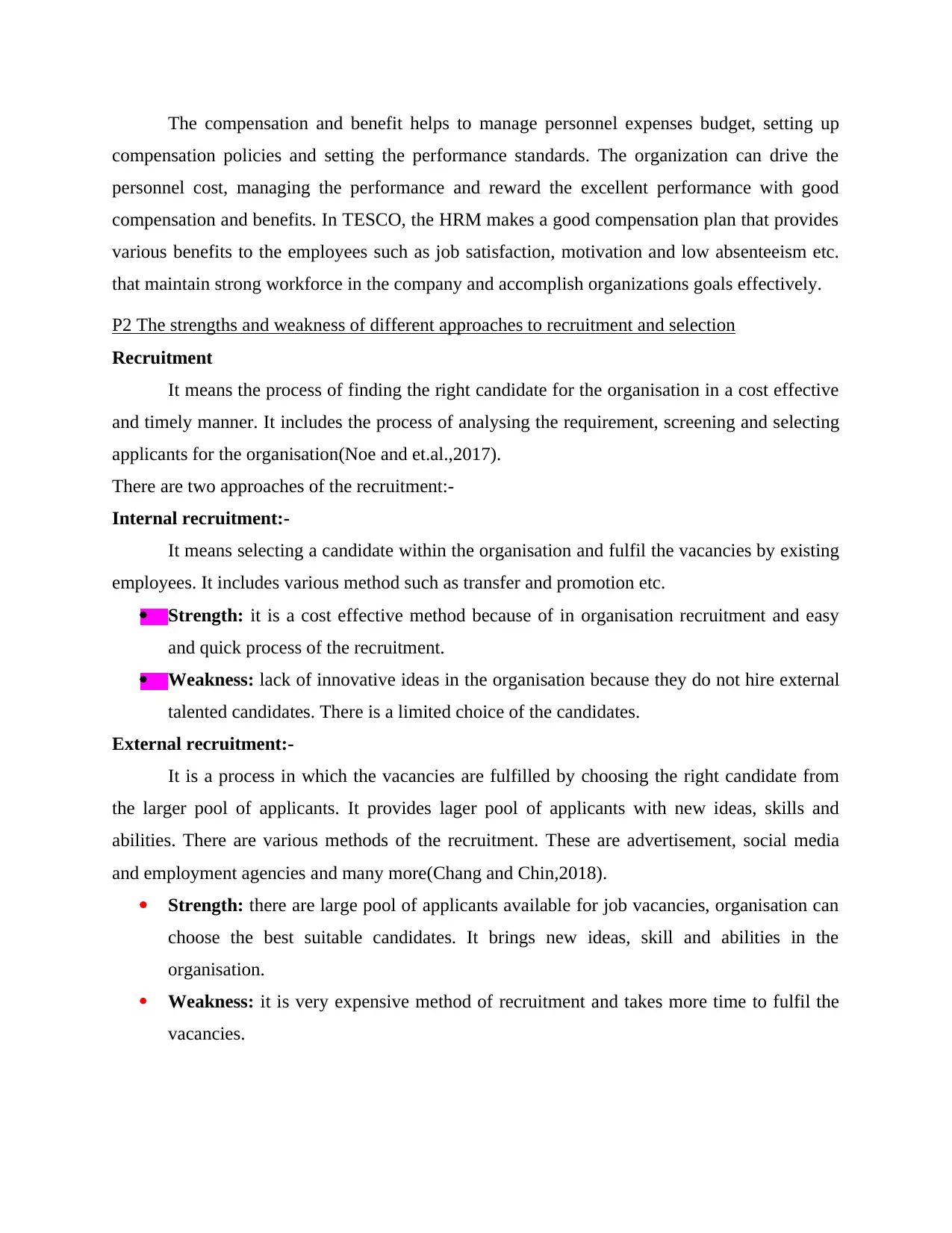
The compensation and benefit helps to manage personnel expenses budget, setting up
compensation policies and setting the performance standards. The organization can drive the
personnel cost, managing the performance and reward the excellent performance with good
compensation and benefits. In TESCO, the HRM makes a good compensation plan that provides
various benefits to the employees such as job satisfaction, motivation and low absenteeism etc.
that maintain strong workforce in the company and accomplish organizations goals effectively.
P2 The strengths and weakness of different approaches to recruitment and selection
Recruitment
It means the process of finding the right candidate for the organisation in a cost effective
and timely manner. It includes the process of analysing the requirement, screening and selecting
applicants for the organisation(Noe and et.al.,2017).
There are two approaches of the recruitment:-
Internal recruitment:-
It means selecting a candidate within the organisation and fulfil the vacancies by existing
employees. It includes various method such as transfer and promotion etc.
Strength: it is a cost effective method because of in organisation recruitment and easy
and quick process of the recruitment.
Weakness: lack of innovative ideas in the organisation because they do not hire external
talented candidates. There is a limited choice of the candidates.
External recruitment:-
It is a process in which the vacancies are fulfilled by choosing the right candidate from
the larger pool of applicants. It provides lager pool of applicants with new ideas, skills and
abilities. There are various methods of the recruitment. These are advertisement, social media
and employment agencies and many more(Chang and Chin,2018).
Strength: there are large pool of applicants available for job vacancies, organisation can
choose the best suitable candidates. It brings new ideas, skill and abilities in the
organisation.
Weakness: it is very expensive method of recruitment and takes more time to fulfil the
vacancies.
compensation policies and setting the performance standards. The organization can drive the
personnel cost, managing the performance and reward the excellent performance with good
compensation and benefits. In TESCO, the HRM makes a good compensation plan that provides
various benefits to the employees such as job satisfaction, motivation and low absenteeism etc.
that maintain strong workforce in the company and accomplish organizations goals effectively.
P2 The strengths and weakness of different approaches to recruitment and selection
Recruitment
It means the process of finding the right candidate for the organisation in a cost effective
and timely manner. It includes the process of analysing the requirement, screening and selecting
applicants for the organisation(Noe and et.al.,2017).
There are two approaches of the recruitment:-
Internal recruitment:-
It means selecting a candidate within the organisation and fulfil the vacancies by existing
employees. It includes various method such as transfer and promotion etc.
Strength: it is a cost effective method because of in organisation recruitment and easy
and quick process of the recruitment.
Weakness: lack of innovative ideas in the organisation because they do not hire external
talented candidates. There is a limited choice of the candidates.
External recruitment:-
It is a process in which the vacancies are fulfilled by choosing the right candidate from
the larger pool of applicants. It provides lager pool of applicants with new ideas, skills and
abilities. There are various methods of the recruitment. These are advertisement, social media
and employment agencies and many more(Chang and Chin,2018).
Strength: there are large pool of applicants available for job vacancies, organisation can
choose the best suitable candidates. It brings new ideas, skill and abilities in the
organisation.
Weakness: it is very expensive method of recruitment and takes more time to fulfil the
vacancies.
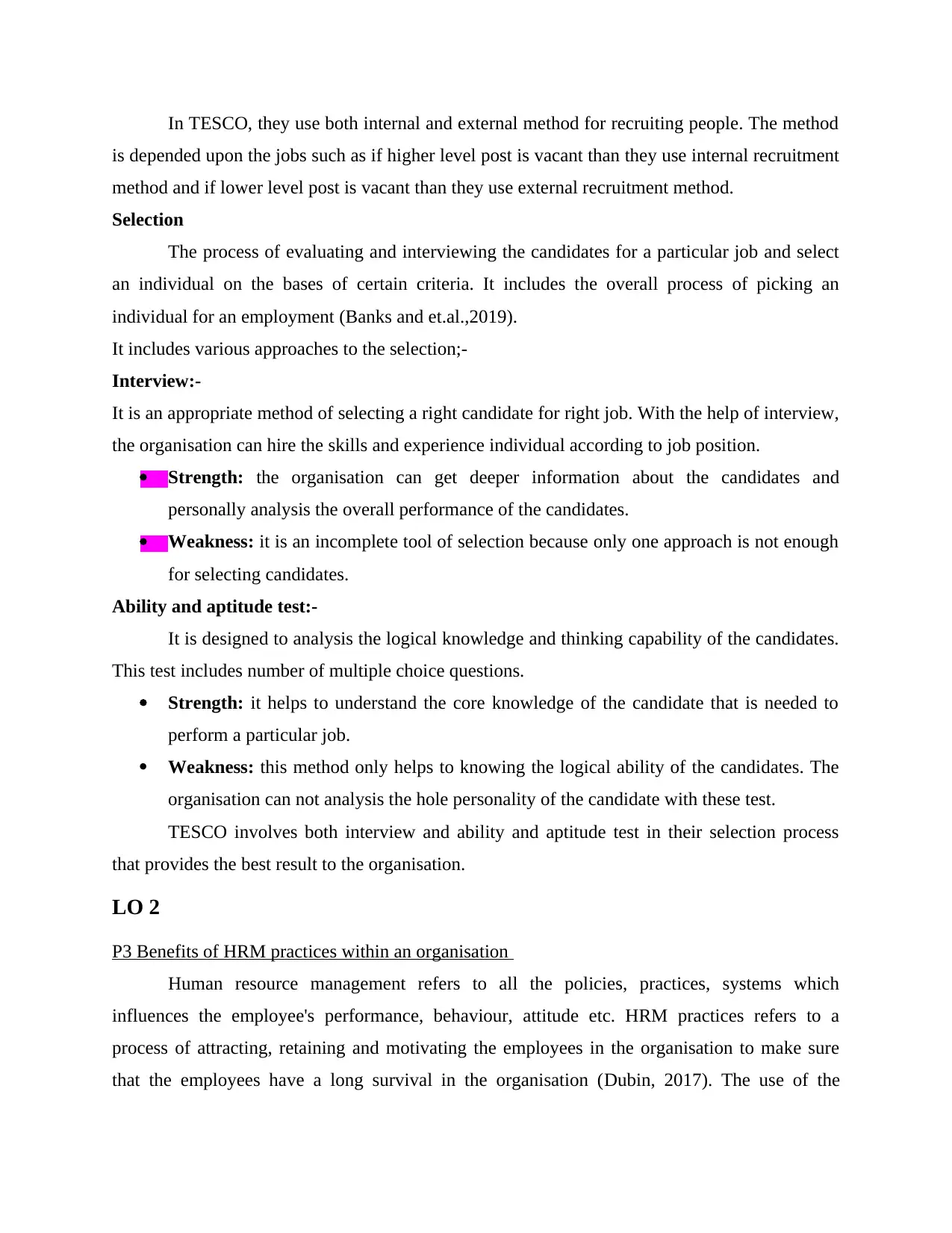
In TESCO, they use both internal and external method for recruiting people. The method
is depended upon the jobs such as if higher level post is vacant than they use internal recruitment
method and if lower level post is vacant than they use external recruitment method.
Selection
The process of evaluating and interviewing the candidates for a particular job and select
an individual on the bases of certain criteria. It includes the overall process of picking an
individual for an employment (Banks and et.al.,2019).
It includes various approaches to the selection;-
Interview:-
It is an appropriate method of selecting a right candidate for right job. With the help of interview,
the organisation can hire the skills and experience individual according to job position.
Strength: the organisation can get deeper information about the candidates and
personally analysis the overall performance of the candidates.
Weakness: it is an incomplete tool of selection because only one approach is not enough
for selecting candidates.
Ability and aptitude test:-
It is designed to analysis the logical knowledge and thinking capability of the candidates.
This test includes number of multiple choice questions.
Strength: it helps to understand the core knowledge of the candidate that is needed to
perform a particular job.
Weakness: this method only helps to knowing the logical ability of the candidates. The
organisation can not analysis the hole personality of the candidate with these test.
TESCO involves both interview and ability and aptitude test in their selection process
that provides the best result to the organisation.
LO 2
P3 Benefits of HRM practices within an organisation
Human resource management refers to all the policies, practices, systems which
influences the employee's performance, behaviour, attitude etc. HRM practices refers to a
process of attracting, retaining and motivating the employees in the organisation to make sure
that the employees have a long survival in the organisation (Dubin, 2017). The use of the
is depended upon the jobs such as if higher level post is vacant than they use internal recruitment
method and if lower level post is vacant than they use external recruitment method.
Selection
The process of evaluating and interviewing the candidates for a particular job and select
an individual on the bases of certain criteria. It includes the overall process of picking an
individual for an employment (Banks and et.al.,2019).
It includes various approaches to the selection;-
Interview:-
It is an appropriate method of selecting a right candidate for right job. With the help of interview,
the organisation can hire the skills and experience individual according to job position.
Strength: the organisation can get deeper information about the candidates and
personally analysis the overall performance of the candidates.
Weakness: it is an incomplete tool of selection because only one approach is not enough
for selecting candidates.
Ability and aptitude test:-
It is designed to analysis the logical knowledge and thinking capability of the candidates.
This test includes number of multiple choice questions.
Strength: it helps to understand the core knowledge of the candidate that is needed to
perform a particular job.
Weakness: this method only helps to knowing the logical ability of the candidates. The
organisation can not analysis the hole personality of the candidate with these test.
TESCO involves both interview and ability and aptitude test in their selection process
that provides the best result to the organisation.
LO 2
P3 Benefits of HRM practices within an organisation
Human resource management refers to all the policies, practices, systems which
influences the employee's performance, behaviour, attitude etc. HRM practices refers to a
process of attracting, retaining and motivating the employees in the organisation to make sure
that the employees have a long survival in the organisation (Dubin, 2017). The use of the
⊘ This is a preview!⊘
Do you want full access?
Subscribe today to unlock all pages.

Trusted by 1+ million students worldwide
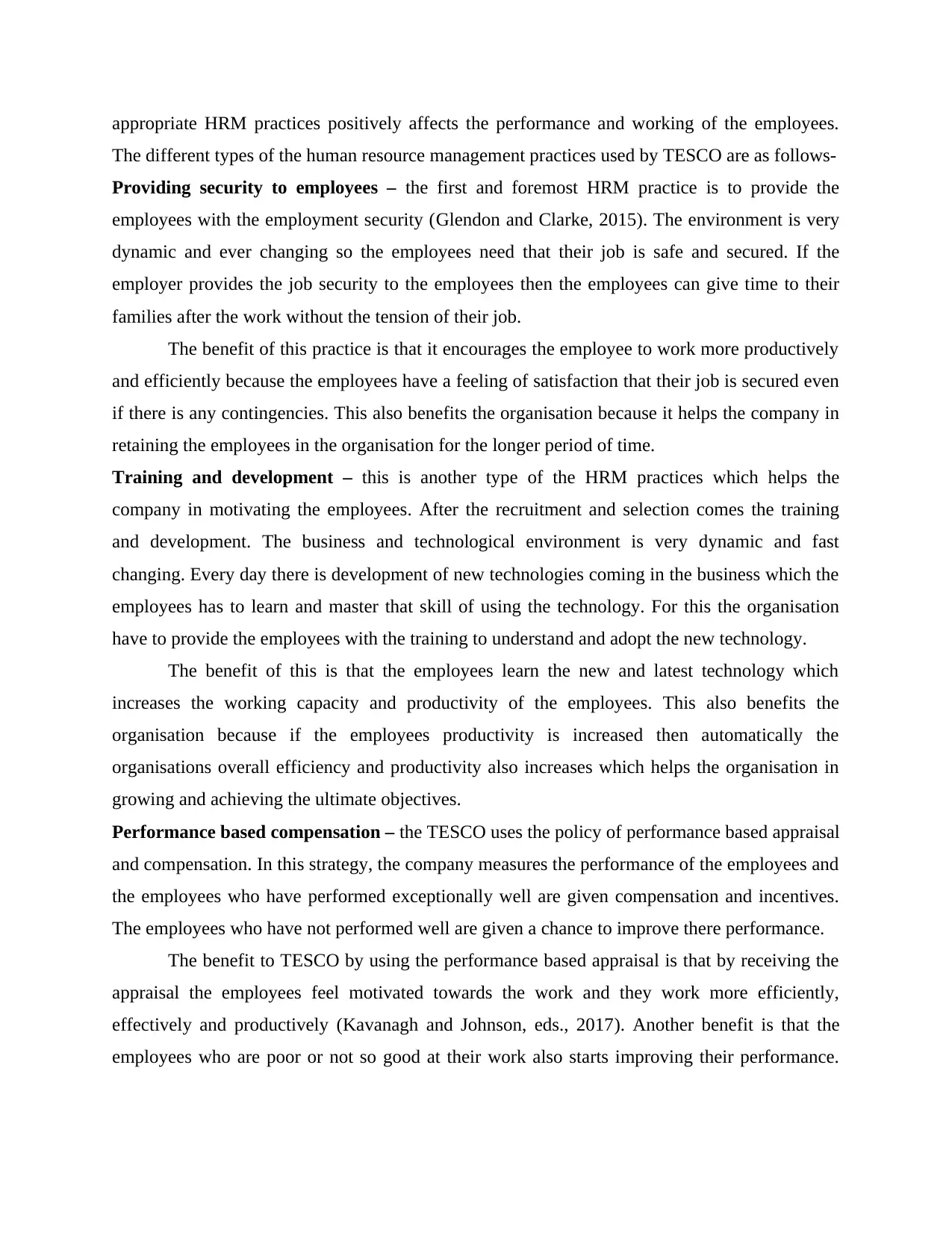
appropriate HRM practices positively affects the performance and working of the employees.
The different types of the human resource management practices used by TESCO are as follows-
Providing security to employees – the first and foremost HRM practice is to provide the
employees with the employment security (Glendon and Clarke, 2015). The environment is very
dynamic and ever changing so the employees need that their job is safe and secured. If the
employer provides the job security to the employees then the employees can give time to their
families after the work without the tension of their job.
The benefit of this practice is that it encourages the employee to work more productively
and efficiently because the employees have a feeling of satisfaction that their job is secured even
if there is any contingencies. This also benefits the organisation because it helps the company in
retaining the employees in the organisation for the longer period of time.
Training and development – this is another type of the HRM practices which helps the
company in motivating the employees. After the recruitment and selection comes the training
and development. The business and technological environment is very dynamic and fast
changing. Every day there is development of new technologies coming in the business which the
employees has to learn and master that skill of using the technology. For this the organisation
have to provide the employees with the training to understand and adopt the new technology.
The benefit of this is that the employees learn the new and latest technology which
increases the working capacity and productivity of the employees. This also benefits the
organisation because if the employees productivity is increased then automatically the
organisations overall efficiency and productivity also increases which helps the organisation in
growing and achieving the ultimate objectives.
Performance based compensation – the TESCO uses the policy of performance based appraisal
and compensation. In this strategy, the company measures the performance of the employees and
the employees who have performed exceptionally well are given compensation and incentives.
The employees who have not performed well are given a chance to improve there performance.
The benefit to TESCO by using the performance based appraisal is that by receiving the
appraisal the employees feel motivated towards the work and they work more efficiently,
effectively and productively (Kavanagh and Johnson, eds., 2017). Another benefit is that the
employees who are poor or not so good at their work also starts improving their performance.
The different types of the human resource management practices used by TESCO are as follows-
Providing security to employees – the first and foremost HRM practice is to provide the
employees with the employment security (Glendon and Clarke, 2015). The environment is very
dynamic and ever changing so the employees need that their job is safe and secured. If the
employer provides the job security to the employees then the employees can give time to their
families after the work without the tension of their job.
The benefit of this practice is that it encourages the employee to work more productively
and efficiently because the employees have a feeling of satisfaction that their job is secured even
if there is any contingencies. This also benefits the organisation because it helps the company in
retaining the employees in the organisation for the longer period of time.
Training and development – this is another type of the HRM practices which helps the
company in motivating the employees. After the recruitment and selection comes the training
and development. The business and technological environment is very dynamic and fast
changing. Every day there is development of new technologies coming in the business which the
employees has to learn and master that skill of using the technology. For this the organisation
have to provide the employees with the training to understand and adopt the new technology.
The benefit of this is that the employees learn the new and latest technology which
increases the working capacity and productivity of the employees. This also benefits the
organisation because if the employees productivity is increased then automatically the
organisations overall efficiency and productivity also increases which helps the organisation in
growing and achieving the ultimate objectives.
Performance based compensation – the TESCO uses the policy of performance based appraisal
and compensation. In this strategy, the company measures the performance of the employees and
the employees who have performed exceptionally well are given compensation and incentives.
The employees who have not performed well are given a chance to improve there performance.
The benefit to TESCO by using the performance based appraisal is that by receiving the
appraisal the employees feel motivated towards the work and they work more efficiently,
effectively and productively (Kavanagh and Johnson, eds., 2017). Another benefit is that the
employees who are poor or not so good at their work also starts improving their performance.
Paraphrase This Document
Need a fresh take? Get an instant paraphrase of this document with our AI Paraphraser
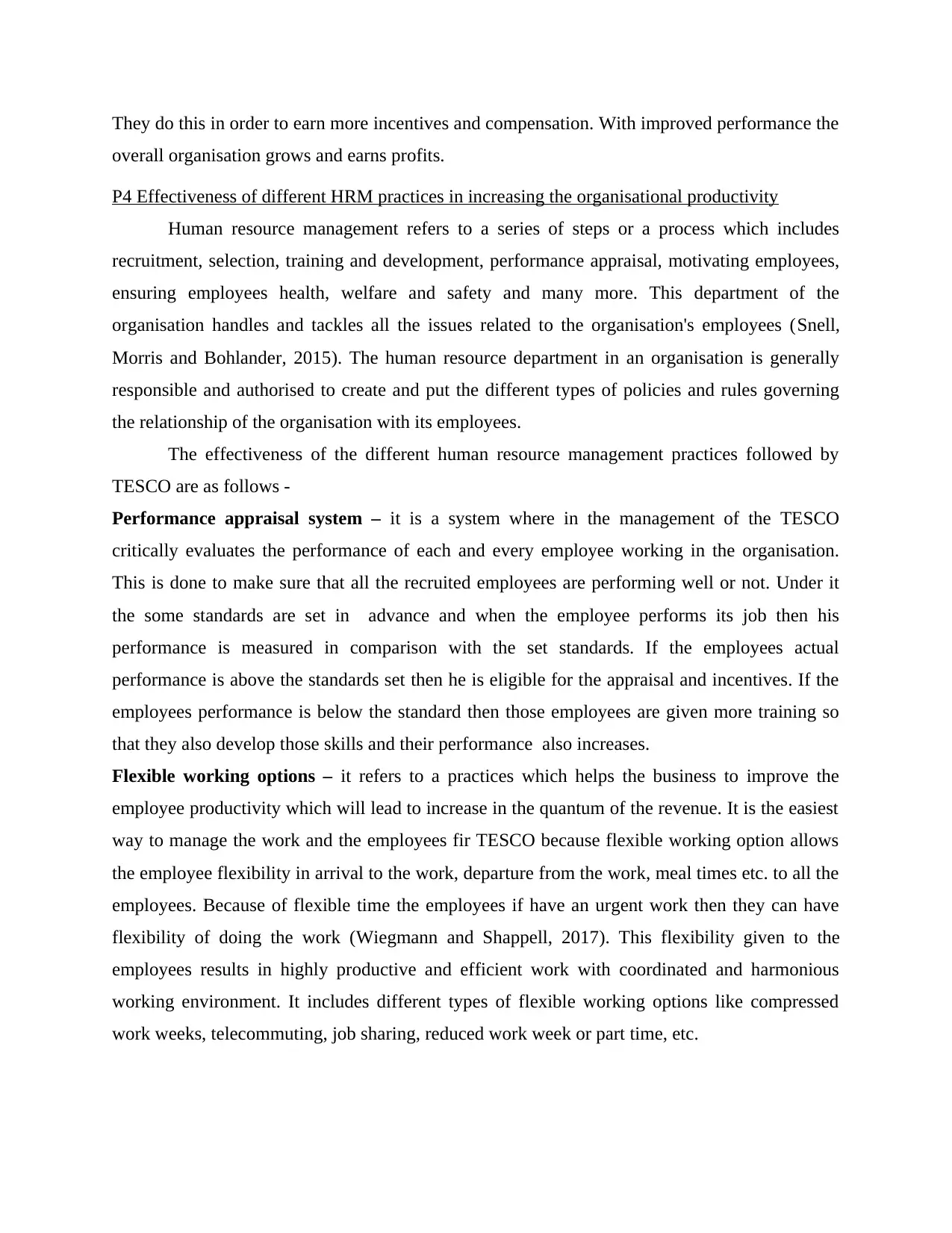
They do this in order to earn more incentives and compensation. With improved performance the
overall organisation grows and earns profits.
P4 Effectiveness of different HRM practices in increasing the organisational productivity
Human resource management refers to a series of steps or a process which includes
recruitment, selection, training and development, performance appraisal, motivating employees,
ensuring employees health, welfare and safety and many more. This department of the
organisation handles and tackles all the issues related to the organisation's employees (Snell,
Morris and Bohlander, 2015). The human resource department in an organisation is generally
responsible and authorised to create and put the different types of policies and rules governing
the relationship of the organisation with its employees.
The effectiveness of the different human resource management practices followed by
TESCO are as follows -
Performance appraisal system – it is a system where in the management of the TESCO
critically evaluates the performance of each and every employee working in the organisation.
This is done to make sure that all the recruited employees are performing well or not. Under it
the some standards are set in advance and when the employee performs its job then his
performance is measured in comparison with the set standards. If the employees actual
performance is above the standards set then he is eligible for the appraisal and incentives. If the
employees performance is below the standard then those employees are given more training so
that they also develop those skills and their performance also increases.
Flexible working options – it refers to a practices which helps the business to improve the
employee productivity which will lead to increase in the quantum of the revenue. It is the easiest
way to manage the work and the employees fir TESCO because flexible working option allows
the employee flexibility in arrival to the work, departure from the work, meal times etc. to all the
employees. Because of flexible time the employees if have an urgent work then they can have
flexibility of doing the work (Wiegmann and Shappell, 2017). This flexibility given to the
employees results in highly productive and efficient work with coordinated and harmonious
working environment. It includes different types of flexible working options like compressed
work weeks, telecommuting, job sharing, reduced work week or part time, etc.
overall organisation grows and earns profits.
P4 Effectiveness of different HRM practices in increasing the organisational productivity
Human resource management refers to a series of steps or a process which includes
recruitment, selection, training and development, performance appraisal, motivating employees,
ensuring employees health, welfare and safety and many more. This department of the
organisation handles and tackles all the issues related to the organisation's employees (Snell,
Morris and Bohlander, 2015). The human resource department in an organisation is generally
responsible and authorised to create and put the different types of policies and rules governing
the relationship of the organisation with its employees.
The effectiveness of the different human resource management practices followed by
TESCO are as follows -
Performance appraisal system – it is a system where in the management of the TESCO
critically evaluates the performance of each and every employee working in the organisation.
This is done to make sure that all the recruited employees are performing well or not. Under it
the some standards are set in advance and when the employee performs its job then his
performance is measured in comparison with the set standards. If the employees actual
performance is above the standards set then he is eligible for the appraisal and incentives. If the
employees performance is below the standard then those employees are given more training so
that they also develop those skills and their performance also increases.
Flexible working options – it refers to a practices which helps the business to improve the
employee productivity which will lead to increase in the quantum of the revenue. It is the easiest
way to manage the work and the employees fir TESCO because flexible working option allows
the employee flexibility in arrival to the work, departure from the work, meal times etc. to all the
employees. Because of flexible time the employees if have an urgent work then they can have
flexibility of doing the work (Wiegmann and Shappell, 2017). This flexibility given to the
employees results in highly productive and efficient work with coordinated and harmonious
working environment. It includes different types of flexible working options like compressed
work weeks, telecommuting, job sharing, reduced work week or part time, etc.
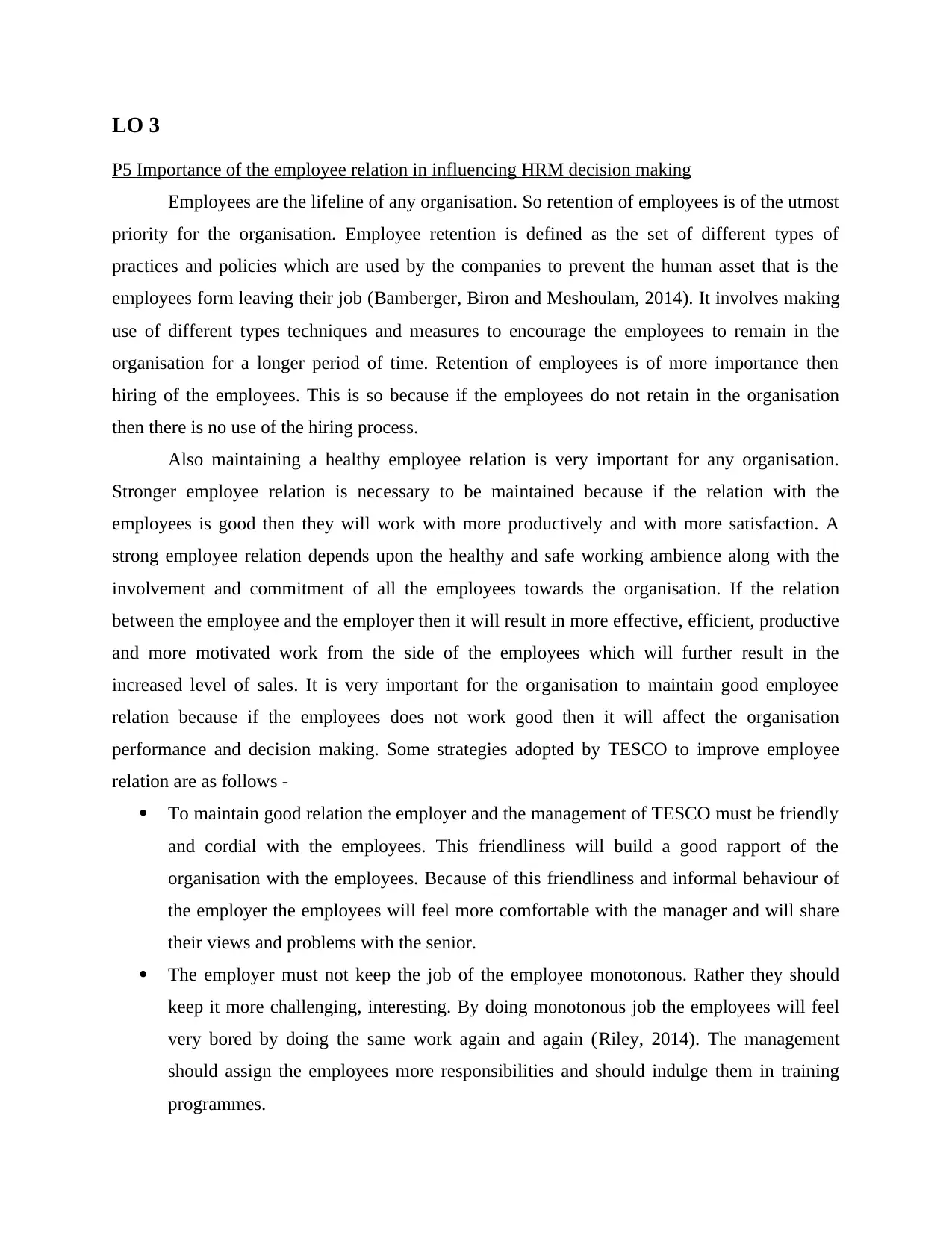
LO 3
P5 Importance of the employee relation in influencing HRM decision making
Employees are the lifeline of any organisation. So retention of employees is of the utmost
priority for the organisation. Employee retention is defined as the set of different types of
practices and policies which are used by the companies to prevent the human asset that is the
employees form leaving their job (Bamberger, Biron and Meshoulam, 2014). It involves making
use of different types techniques and measures to encourage the employees to remain in the
organisation for a longer period of time. Retention of employees is of more importance then
hiring of the employees. This is so because if the employees do not retain in the organisation
then there is no use of the hiring process.
Also maintaining a healthy employee relation is very important for any organisation.
Stronger employee relation is necessary to be maintained because if the relation with the
employees is good then they will work with more productively and with more satisfaction. A
strong employee relation depends upon the healthy and safe working ambience along with the
involvement and commitment of all the employees towards the organisation. If the relation
between the employee and the employer then it will result in more effective, efficient, productive
and more motivated work from the side of the employees which will further result in the
increased level of sales. It is very important for the organisation to maintain good employee
relation because if the employees does not work good then it will affect the organisation
performance and decision making. Some strategies adopted by TESCO to improve employee
relation are as follows -
To maintain good relation the employer and the management of TESCO must be friendly
and cordial with the employees. This friendliness will build a good rapport of the
organisation with the employees. Because of this friendliness and informal behaviour of
the employer the employees will feel more comfortable with the manager and will share
their views and problems with the senior.
The employer must not keep the job of the employee monotonous. Rather they should
keep it more challenging, interesting. By doing monotonous job the employees will feel
very bored by doing the same work again and again (Riley, 2014). The management
should assign the employees more responsibilities and should indulge them in training
programmes.
P5 Importance of the employee relation in influencing HRM decision making
Employees are the lifeline of any organisation. So retention of employees is of the utmost
priority for the organisation. Employee retention is defined as the set of different types of
practices and policies which are used by the companies to prevent the human asset that is the
employees form leaving their job (Bamberger, Biron and Meshoulam, 2014). It involves making
use of different types techniques and measures to encourage the employees to remain in the
organisation for a longer period of time. Retention of employees is of more importance then
hiring of the employees. This is so because if the employees do not retain in the organisation
then there is no use of the hiring process.
Also maintaining a healthy employee relation is very important for any organisation.
Stronger employee relation is necessary to be maintained because if the relation with the
employees is good then they will work with more productively and with more satisfaction. A
strong employee relation depends upon the healthy and safe working ambience along with the
involvement and commitment of all the employees towards the organisation. If the relation
between the employee and the employer then it will result in more effective, efficient, productive
and more motivated work from the side of the employees which will further result in the
increased level of sales. It is very important for the organisation to maintain good employee
relation because if the employees does not work good then it will affect the organisation
performance and decision making. Some strategies adopted by TESCO to improve employee
relation are as follows -
To maintain good relation the employer and the management of TESCO must be friendly
and cordial with the employees. This friendliness will build a good rapport of the
organisation with the employees. Because of this friendliness and informal behaviour of
the employer the employees will feel more comfortable with the manager and will share
their views and problems with the senior.
The employer must not keep the job of the employee monotonous. Rather they should
keep it more challenging, interesting. By doing monotonous job the employees will feel
very bored by doing the same work again and again (Riley, 2014). The management
should assign the employees more responsibilities and should indulge them in training
programmes.
⊘ This is a preview!⊘
Do you want full access?
Subscribe today to unlock all pages.

Trusted by 1+ million students worldwide
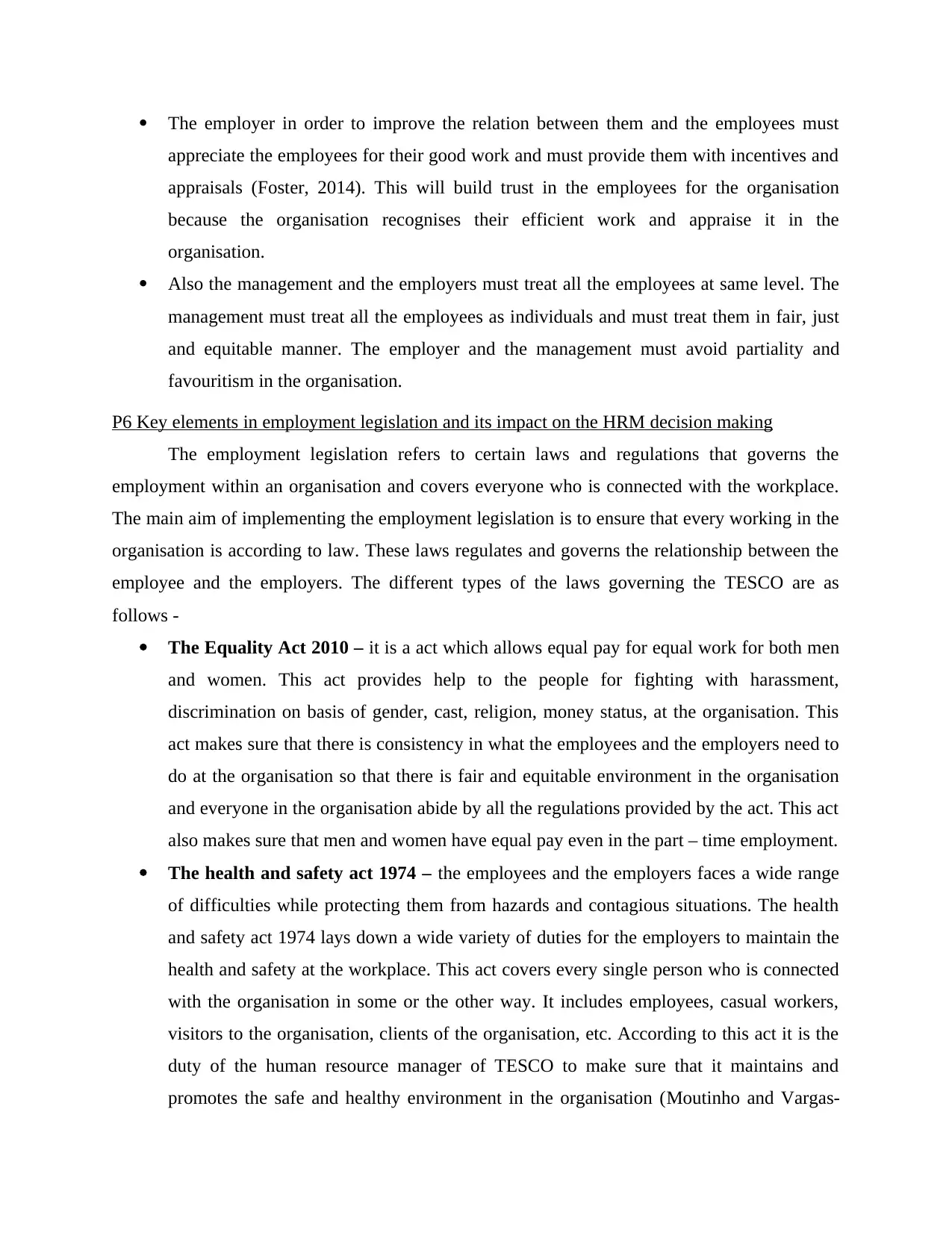
The employer in order to improve the relation between them and the employees must
appreciate the employees for their good work and must provide them with incentives and
appraisals (Foster, 2014). This will build trust in the employees for the organisation
because the organisation recognises their efficient work and appraise it in the
organisation.
Also the management and the employers must treat all the employees at same level. The
management must treat all the employees as individuals and must treat them in fair, just
and equitable manner. The employer and the management must avoid partiality and
favouritism in the organisation.
P6 Key elements in employment legislation and its impact on the HRM decision making
The employment legislation refers to certain laws and regulations that governs the
employment within an organisation and covers everyone who is connected with the workplace.
The main aim of implementing the employment legislation is to ensure that every working in the
organisation is according to law. These laws regulates and governs the relationship between the
employee and the employers. The different types of the laws governing the TESCO are as
follows -
The Equality Act 2010 – it is a act which allows equal pay for equal work for both men
and women. This act provides help to the people for fighting with harassment,
discrimination on basis of gender, cast, religion, money status, at the organisation. This
act makes sure that there is consistency in what the employees and the employers need to
do at the organisation so that there is fair and equitable environment in the organisation
and everyone in the organisation abide by all the regulations provided by the act. This act
also makes sure that men and women have equal pay even in the part – time employment.
The health and safety act 1974 – the employees and the employers faces a wide range
of difficulties while protecting them from hazards and contagious situations. The health
and safety act 1974 lays down a wide variety of duties for the employers to maintain the
health and safety at the workplace. This act covers every single person who is connected
with the organisation in some or the other way. It includes employees, casual workers,
visitors to the organisation, clients of the organisation, etc. According to this act it is the
duty of the human resource manager of TESCO to make sure that it maintains and
promotes the safe and healthy environment in the organisation (Moutinho and Vargas-
appreciate the employees for their good work and must provide them with incentives and
appraisals (Foster, 2014). This will build trust in the employees for the organisation
because the organisation recognises their efficient work and appraise it in the
organisation.
Also the management and the employers must treat all the employees at same level. The
management must treat all the employees as individuals and must treat them in fair, just
and equitable manner. The employer and the management must avoid partiality and
favouritism in the organisation.
P6 Key elements in employment legislation and its impact on the HRM decision making
The employment legislation refers to certain laws and regulations that governs the
employment within an organisation and covers everyone who is connected with the workplace.
The main aim of implementing the employment legislation is to ensure that every working in the
organisation is according to law. These laws regulates and governs the relationship between the
employee and the employers. The different types of the laws governing the TESCO are as
follows -
The Equality Act 2010 – it is a act which allows equal pay for equal work for both men
and women. This act provides help to the people for fighting with harassment,
discrimination on basis of gender, cast, religion, money status, at the organisation. This
act makes sure that there is consistency in what the employees and the employers need to
do at the organisation so that there is fair and equitable environment in the organisation
and everyone in the organisation abide by all the regulations provided by the act. This act
also makes sure that men and women have equal pay even in the part – time employment.
The health and safety act 1974 – the employees and the employers faces a wide range
of difficulties while protecting them from hazards and contagious situations. The health
and safety act 1974 lays down a wide variety of duties for the employers to maintain the
health and safety at the workplace. This act covers every single person who is connected
with the organisation in some or the other way. It includes employees, casual workers,
visitors to the organisation, clients of the organisation, etc. According to this act it is the
duty of the human resource manager of TESCO to make sure that it maintains and
promotes the safe and healthy environment in the organisation (Moutinho and Vargas-
Paraphrase This Document
Need a fresh take? Get an instant paraphrase of this document with our AI Paraphraser

Sanchez, eds., 2018). For this TESCO can adopt policies like protecting the employees
against use of some dangerous chemicals, breakdown of machinery, falls and tripping of
lights etc.
The anti – discrimination act 1977 – this act is made to prohibit and restrict the
unlawful practices like gender, racial, age, demographic discrimination that happens at
the workplace. This act is being formulated to prevent the discrimination which may
occur at the work place due to many reasons such as culture, class, religion, status, age,
gender etc. (Kramar, 2014). The human resource department of TESCO should take
immense care of this act and should avoid doing discrimination among the employees.
The human resource manager of TESCO should take such fair and equitable decisions
which provides equal pay for all the employees according to their work so that no
employee develops a feeling of getting discriminated.
All these laws affects the HRM decision making. It is so because the organisation is always
affected by the laws applicable to the company. So before taking any decision the company has
to follow and check all the laws before taking the decision.
LO 4
P7 HRM practices
Job description – it is a type of document which describes the general duties, roles and
responsibilities of a particular job position. It have details about the job role, working hours,
duties and responsibilities, working condition etc.
Job specification – job specification is a statement which explains the minimum requirements
that are needed for the post for which the job specification is made (Tyson, 2014). It includes
personal qualification required by the candidate, previous experience, different types of skills
and traits etc.
Job description and specification for TESCO 's requirement of human resource assistant
manager.
Company name TESCO plc
Job title Human resource assistant
Report to Human resource manager
against use of some dangerous chemicals, breakdown of machinery, falls and tripping of
lights etc.
The anti – discrimination act 1977 – this act is made to prohibit and restrict the
unlawful practices like gender, racial, age, demographic discrimination that happens at
the workplace. This act is being formulated to prevent the discrimination which may
occur at the work place due to many reasons such as culture, class, religion, status, age,
gender etc. (Kramar, 2014). The human resource department of TESCO should take
immense care of this act and should avoid doing discrimination among the employees.
The human resource manager of TESCO should take such fair and equitable decisions
which provides equal pay for all the employees according to their work so that no
employee develops a feeling of getting discriminated.
All these laws affects the HRM decision making. It is so because the organisation is always
affected by the laws applicable to the company. So before taking any decision the company has
to follow and check all the laws before taking the decision.
LO 4
P7 HRM practices
Job description – it is a type of document which describes the general duties, roles and
responsibilities of a particular job position. It have details about the job role, working hours,
duties and responsibilities, working condition etc.
Job specification – job specification is a statement which explains the minimum requirements
that are needed for the post for which the job specification is made (Tyson, 2014). It includes
personal qualification required by the candidate, previous experience, different types of skills
and traits etc.
Job description and specification for TESCO 's requirement of human resource assistant
manager.
Company name TESCO plc
Job title Human resource assistant
Report to Human resource manager
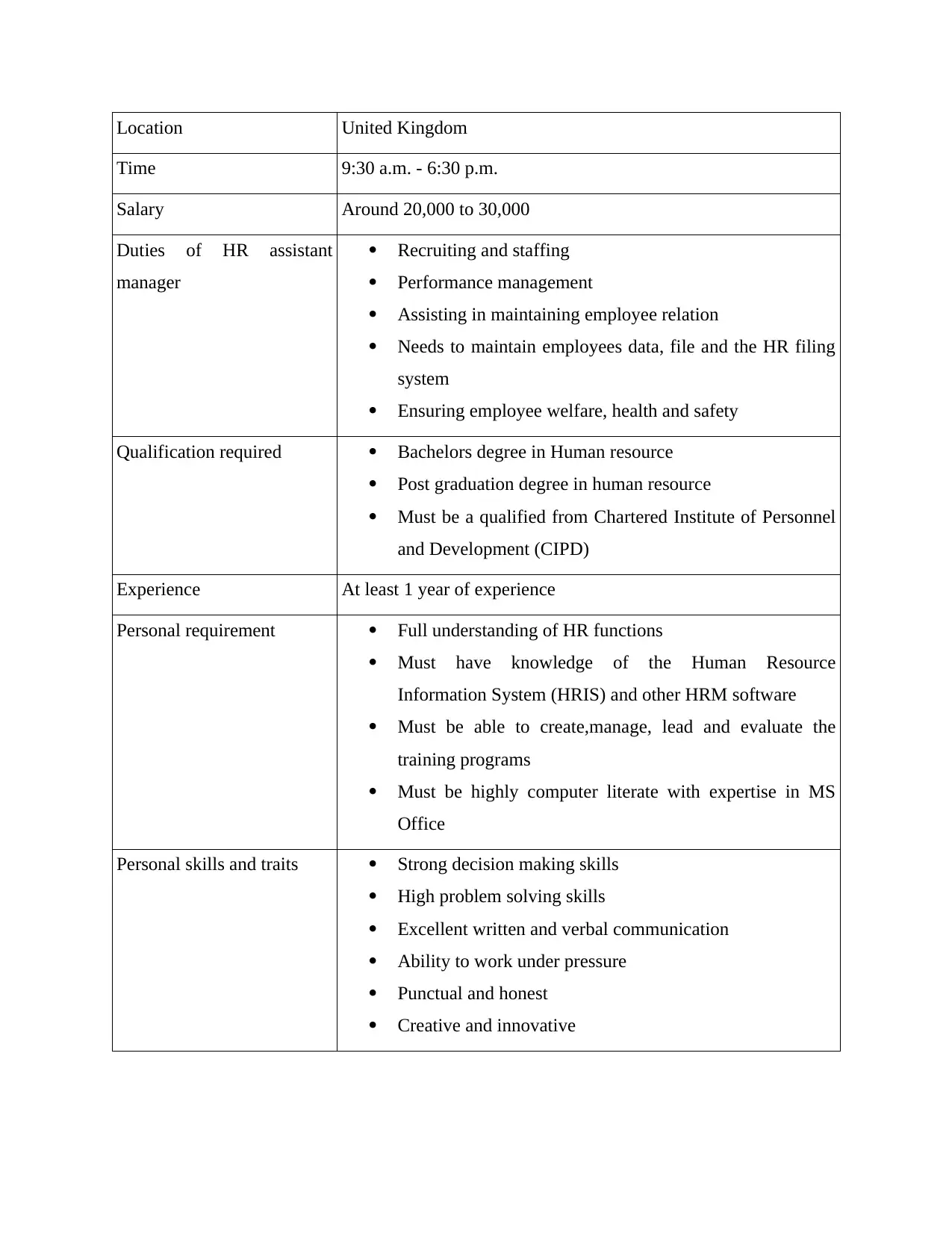
Location United Kingdom
Time 9:30 a.m. - 6:30 p.m.
Salary Around 20,000 to 30,000
Duties of HR assistant
manager
Recruiting and staffing
Performance management
Assisting in maintaining employee relation
Needs to maintain employees data, file and the HR filing
system
Ensuring employee welfare, health and safety
Qualification required Bachelors degree in Human resource
Post graduation degree in human resource
Must be a qualified from Chartered Institute of Personnel
and Development (CIPD)
Experience At least 1 year of experience
Personal requirement Full understanding of HR functions
Must have knowledge of the Human Resource
Information System (HRIS) and other HRM software
Must be able to create,manage, lead and evaluate the
training programs
Must be highly computer literate with expertise in MS
Office
Personal skills and traits Strong decision making skills
High problem solving skills
Excellent written and verbal communication
Ability to work under pressure
Punctual and honest
Creative and innovative
Time 9:30 a.m. - 6:30 p.m.
Salary Around 20,000 to 30,000
Duties of HR assistant
manager
Recruiting and staffing
Performance management
Assisting in maintaining employee relation
Needs to maintain employees data, file and the HR filing
system
Ensuring employee welfare, health and safety
Qualification required Bachelors degree in Human resource
Post graduation degree in human resource
Must be a qualified from Chartered Institute of Personnel
and Development (CIPD)
Experience At least 1 year of experience
Personal requirement Full understanding of HR functions
Must have knowledge of the Human Resource
Information System (HRIS) and other HRM software
Must be able to create,manage, lead and evaluate the
training programs
Must be highly computer literate with expertise in MS
Office
Personal skills and traits Strong decision making skills
High problem solving skills
Excellent written and verbal communication
Ability to work under pressure
Punctual and honest
Creative and innovative
⊘ This is a preview!⊘
Do you want full access?
Subscribe today to unlock all pages.

Trusted by 1+ million students worldwide
1 out of 16
Related Documents
Your All-in-One AI-Powered Toolkit for Academic Success.
+13062052269
info@desklib.com
Available 24*7 on WhatsApp / Email
![[object Object]](/_next/static/media/star-bottom.7253800d.svg)
Unlock your academic potential
Copyright © 2020–2025 A2Z Services. All Rights Reserved. Developed and managed by ZUCOL.





